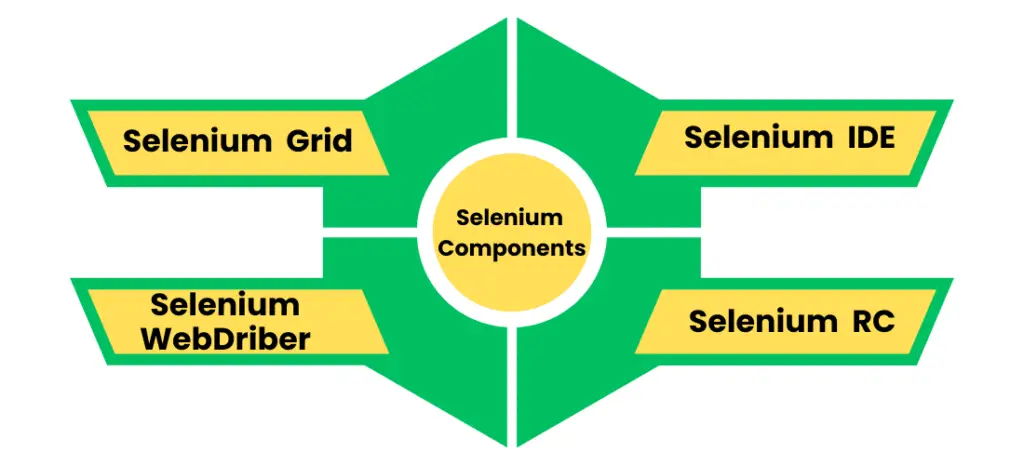

What Is Selenium
When it comes to cross-browser testing, the testing community uses a set of tools called Selenium. Selenium is limited to browser use and cannot automate desktop apps. It is regarded as one of the most popular tool suites for automated testing of online applications because of its solid support for widely used web browsers.
Through the use of suitable drivers, such as ChromeDriver, GeckoDriver, EdgeDriver, SafariDriver, and OperaDriver, Selenium WebDriver also supports widely used browsers, including Firefox, Chrome, Edge, Safari, and Opera.
Additionally, Selenium offers connectivity with a variety of programming languages, including PHP, Python, Ruby, JavaScript, C#, and Java. Selenium is quite flexible, allowing testers to select the language in which to create test cases.
A framework for the web that lets you run cross-browser testing is called Selenium WebDriver. With the help of this program, web-based applications may be automatically tested to make sure they function as planned.
That can select the programming language you want to use when writing test scripts using Selenium WebDriver. As was previously said, it is an improvement over Selenium RC in order to get over a few restrictions. Window elements cannot be handled by Selenium WebDriver; however, this limitation can be addressed by utilizing technologies such as Sikuli, Auto IT, etc.
The various steps involved in Selenium WebDriver script are as follows:
- Install eclipse Oxygen IDE then configure Selenium server jar inside the eclipse and create a java project selecting Java SE 1.8.
- Create a webdriver object and upcast any browser driver like chromedriver,firefox,driver, edgedriver to webdriver in order to launch an empty browser.
- After launching any web browser go to any webpage using get() method or navigate() method and the URL link of that page inside the get or navigate method parameter.
- Locate any of the elements in that webpage using appropriate locators like id,name,class name,tagname,link text,partiallinktext,css selector and tagname.
- Perform actions on those elements using click() and sendkeys() method. Then handle any alerts and frames if present.
- Compare the expected results with actual results using Assertions.

The primary function of the Selenium IDE (Integrated Development Environment) is as a record/run utility. It is an extension or add-on that works with both Firefox and Chrome, allowing it to record and replay content to quickly develop tests.
A framework for the web that lets you run cross-browser testing is called Selenium WebDriver. With the help of this program, web-based applications may be automatically tested to make sure they function as planned.
Working with Selenium RC (Remote Control) needs at least a basic understanding of one programming language. With the help of this application, you may create responsive design tests in any preferred scripting language. Selenium RC consists of two primary components: server libraries and client libraries. It has restrictions and a complicated architecture.
A method of testing called Selenium Grid is used to run test cases continuously on several browsers, computers, and OS systems. Cross-browser compatibility testing is made very simple with this application. The Selenium Grid comes in two versions: Grid 1, which is the more modern version, and Grid 2, which is the older version.
A web framework that lets you run cross-browser testing is called Selenium WebDriver. With the help of this application, web-based applications may be automatically tested to make sure they function as intended.
You can select the programming language you want to use when writing test scripts using Selenium WebDriver. As was previously said, it is an improvement over Selenium RC in order to get over a few restrictions. Window components cannot be handled by Selenium WebDriver; however, this limitation can be addressed by utilising technologies such as Sikuli, Auto IT, etc.
- Test commands are transformed by the JSON wire protocol into an HTTP request.
- Every browser has its own driver, which initialises the server before any test cases are executed.
- After that, the request is received by the browser via its driver.
- One of the most popular Open-Source tools for web application testing is simple to use and gets you started quickly. You may also use it to assess cross-browser compatibility.
- Numerous operating systems are supported, including Windows, Mac, Linux, Unix, and others.
- It can be used with many different languages, such as Python, Java, Perl, Ruby, and so on.
- supports the most recent versions of Internet Explorer, Firefox, Chrome, and Safari browsers.
- Compared to other solutions, Selenium WebDriver completes test script execution more quickly.
- API (Application Programming Interface) that is more simple than Selenium RC
- Additionally, it has HtmlUnitDriver, AndroidDriver, and iPhoneDriver compatibility.
In conclusion, the world of Selenium Web Driver offers endless possibilities for automating web tasks and enhancing your testing processes. By following this Selenium Web tutorial, you have taken the first step towards leveraging the power of Selenium Web Driver to streamline your workflows and achieve optimal results. Keep practising, exploring, and experimenting with different features and functionalities to become a proficient Selenium Web Driver user. Embrace this powerful tool and elevate your testing efficiency to new heights.
Consult Us


















